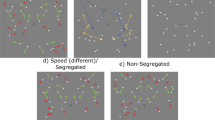Abstract
Symmetry is usually computationally expensive to detect reliably, while it is relatively easy to perceive. In spite of many attempts to understand the neurofunctional properties of symmetry processing, no symmetry-specific activation was found in earlier cortical areas. Psychophysical evidence relating to the processing mechanisms suggests that the basic processes of symmetry perception would not perform a serial, point-by-point comparison of structural features but rather operate in parallel. Here, modeling of neural processes in psychophysical detection of bilateral texture symmetry is considered. A simple fine-grained algorithm that is capable of performing symmetry estimation without explicit comparison of remote elements is introduced. A computational model of symmetry perception is then described to characterize the underlying mechanisms as one-dimensional spatio-temporal neural processes, each of which is mediated by intracellular horizontal connections in primary visual cortex and adopts the proposed algorithm for the neural computation. Simulated experiments have been performed to show the efficiency and the dynamics of the model. Model and human performances are comparable for symmetry perception of intensity images. Interestingly, the responses of V1 neurons to propagation activities reflecting higher-order perceptual computations have been reported in neurophysiologic experiments.






Similar content being viewed by others
References
Angelucci A, Levitt JB, Walton EJS, Hupe J, Bullier J, Lund JS (2002) Circuits for local and global signal integration in primary visual cortex. J Neurosci 22(19):8633–8646
Barlow HB, Reeves BC (1979) The versatility and absolute efficiency of detecting mirror symmetry in random dot displays. Vis Res 19:783–793
Bonneh Y, Reisfeld D, Yeshurun Y (2002) Quantification of local symmetry: application to texture discrimination. In: Tyler CW (ed) Human symmetry perception and its computational analysis. Lawrence Erlbaum Associates, Mahwah, pp 304–314
Bosking WH, Zhang Y, Schofield B, Fitzpatrick D (1997) Orientation selectivity and the arrangement of horizontal connections in tree shrew striate cortex. J Neurosci 17(6):2112–2127
Bruce V, Morgan M (1975) Violations of symmetry and repetition in visual patterns. Perception 4:239–249
Carmody D, Nodine C, Locher P (1977) Global detection of symmetry. Percept Motor Skills 45:1267–1273
Campbell SR, Wang DL, Jayaprakash C (1999) Synchrony and desynchrony in integrate-and-fire oscillators. Neural Comput 11:1595–11619
Chen CC, Tyler CW, Liu CL, Wang YH (2005) lateral modulation of BOLD activation in unstimulated regions of the human visual cortex. Neuroimage 24:802–809
Dakin SC, Herbert AM (1998) The spatial region of integration for visual symmetry detection. Proc R Soc Lond B 265:659–664
Dakin SC, Hess RF (1997) The spatial mechanisms mediating symmetry perception. Vis Res 37:2915–2930
Dakin SC, Watt RJ (1994) Detection of bilateral symmetry using spatial filters. Spatial Vis 8:393–413
Driver J, Baylis GC, Rafal RD (1992) Preserved figure-ground segregation and symmetry perception in visual neglect. Nature 360:73–75
Driver J, Davis G, Ricciardelli P, Kidd P, Maxwell E, Baron-Cohen S (1999) Gaze perception triggers reflexive spatio-temporal orienting. Visual Cogn 5:509–540
Dry M (2008) Using relational structure to detect symmetry: a voronoi tessellation based model of symmetry perception. Acta Psychol 128:75–90
Gray CM, Singer W (1989) Stimulus-specific neuronal oscillations in orientation columns of cat visual cortex. Proc Natl Acad Sci 86(5):1698–1702
Gurnsey R, Herbert AM, Kenemy J (1998) Bilateral symmetry embedded in noise is detected accurately only at fixation. Vis Res 38:3795–3803
Herbert AM, Overbury O, Singh J, Faubert J (2002) Aging and bilateral symmetry detection. J Gerontol Ser B: Psychol Sci Soc Sci 57:241–245
Julesz B (1996) Binocular disappearance of monocular symmetry. Science 153:657–658
Kanwisher N (2000) Domain specificity in face perception. Nat Neurosci 3:759–763
Kimia BB (2003) On the role of medial geometry in human vision. J Physiol Paris 97(2–3):155–190
Kiryati N, Gofman Y (1998) Detecting symmetry in grey level images: the global optimization approach. Intl J Comput Vis 29:29–45
Kovesi P (1999) Image features from phase congruency. Videre: J Comput Vis Res 1(3):2–26
Lee TS (1996) Neurophysiological evidence for image segmentation and medial axis computation in primate V1. In: Computation and neural system, proceedings of the fourth annual computational neuroscience conference. Kluwer, The Netherlands
Lee TS, Mumford D, Romero R, Lamme VA (1998) The role of the primary visual cortex in higher level vision. Vis Res 38:2429–2454
Mancini S, Sally SL, Gurnsey R (2005) Detection of symmetry and antisymmetry. Vis Res 45:2145–2160
Michalewicz Z (1996) Genetic algorithm + data structures = evolution programming, 3rd edn. Springer, New York
Moller AP, Swaddle JP (1997) Asymmetry, developmental stability and evolution. Oxford University Press, Oxford
Morrone MC, Burr DC (1988) Feature detection in human vision: a phase-dependent energy model. Proc R Soc Lond B 235:221–245
Norcia AM, Candy TR, Petter MW, Vildavski VY, Tyler CW (2002) Temporal dynamics of the human response to symmetry. J Vis 2:132–139
Oka S, Victor JD, Conte MM, Yanagida T (2007) VEPs elicited by local correlations and global symmetry: characteristics and interactions. Vis Res 47:2212–2222
Osorio D (1996) Symmetry detection by categorization of spatial phase, a model. Proc R Soc Lond B 263:105–110
Palmer SE (1983) The psychology of perceptual organization. In: Beck J, Hope B, Rosenfeld A (eds) Human and machine vision. Academic Press, New York, pp 269–339
Poirier FJAM, Wilson HR (2010) A biologically plausible model of human shape symmetry perception. J Vis 10(1):1–16
Rainville SJM, Kingdom FAA (1999) Spatial-scale contribution to the detection of mirror symmetry in fractal noise. J Opt Soc Am A 16:2112–2123
Rainville SJM, Kingdom FAA (2000) The functional role of oriented spatial filters in the perception of mirror symmetry-psychophysics and modelling. Vis Res 40:2621–2644
Rainville SJM, Kingdom FAA (2002) Scale invariance is driven by stimulus density. Vis Res 42:351–367
Rhodes G, Proffitt F, Grady JM, Sumich A (1998) Facial symmetry and the perception of beauty. Psychon Bull Rev 5:659–669
Royer FL (1981) Detection of symmetry. J Exp Psychol: Hum Percept Perform 7:1186–1210
Schmidt KE, Goebel R, Lowell S, Singer W (1997) The perceptual grouping criterion of colinearity is reflected by anisotropies of connections in the primary visual cortex. Eur J Neurosci 9:1083–1089
Scognamillo R, Rhodes G, Morrone C (2003) A feature-based model of symmetry detection. Proc R Soc Lond B 270:1727–1733
Thornhill R, Gangestad SW (1994) Human fluctuating asymmetry and sexual behavior. Psychol Sci 5:297–302
Ts’o DY, Gilbert CD, Wiesel TN (1986) Relationships between horizontal interaction and functional architecture in cat striate cortex as revealed by cross-correlation analysis. J Neurosci 6:1160–1170
Tyler CW, Baseler HA (1998) Properties of the middle occipital gyrus: an fMRI study. Soc Neurosci Abstr 24:1507
Tyler CW, Baseler HA, Kontsevich LL, Likova LT, Wade AR, Wandell BA (2005) Predominantly extra-retinotopic cortical response to pattern symmetry. Neuroimage 15:306–314
Tyler CW, Hardage L, Miller RT (1995) Multiple mechanisms for the detection of mirror symmetry. Spatial Vis 9:79–100
Ullman S (1984) Visual routines. Cognition 18:97–159
Van Der Helm PA, Leeuwenberg ELJ (2004) Holographic goodness is not that bad: reply to Olivers, Chater, and Watson. Psychol Rev 111:261–273
Van Der Helm PA (2010) Weber-Fechner behaviour in symmetry detection. Atten Percept Psychophys 72:1854–1864
Van Der Zwan R, Leo E, Joung W, Latimer C, Wenderoth P (1998) Evidence that both area V1 and extrastriate visual cortex contribute to symmetry perception. Curr Biol 8:889–892
Victor JD, Conte MM (2004) Local processes and spatial pooling in texture and symmetry detection. Vis Res 45:1063–1073
Wagemans J, Van Gool L, Swinnen V, Van Horebeek J (1993) Higher-order structure in regularity detection. Vis Res 33:1067–1088
Wagemans J (1997) Characteristics and models of human symmetry detection. Trends Cogn Sci 1:346–352
Wagemans J (1999) Parallel visual processes in symmetry perception: normality and pathology. Docum Ophthalmol 95:359–370
Zhu T (2010) Fourier cross-sectional profile for vessel detection on retinal images. Comput Med Imaging Graph 34:203–212
Author information
Authors and Affiliations
Corresponding author
Additional information
Part of the work was performed when Tao Zhu was with AT&T Redditch UK.
Rights and permissions
About this article
Cite this article
Zhu, T. Neural processes in symmetry perception: a parallel spatio-temporal model. Biol Cybern 108, 121–131 (2014). https://doi.org/10.1007/s00422-013-0578-y
Received:
Accepted:
Published:
Issue Date:
DOI: https://doi.org/10.1007/s00422-013-0578-y




